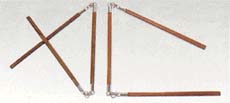
As all other okinawan weaponry, the origin of this
weapon is obscure. Some say it has a Chinese origin, others say it was developped
from a horsebit, but it seems like it was used by peasant to beat the rice.
It probably came into action somewhere in the 16th century, like saï, tonfa,
etc. The nunchaku is made out of 2 sticks, usually some hard wood, and connected
with a rope (it used to be a horsetailhair) or a chain. As the sticky vary in
length, size and weight, so does the length of the connection between the two
sticks. The nunchaku stick is normally as long as the forearm but it is up to
your personnal favor to make it as long as you want.
|

There are a heap of variations of a normal nunchaku. It seems that the Chinese
had a round stick nunchaku, or maru gata nunchaku. The Japanese made it
a little more efficient by making the sticks octogonal (8 sides). This nunchaku
is called hakabukei nunchaku. Then, there is a nunchaku with one long
stick and a short stick, which is called so setsu kon nunchaku. It
should prevent you from hitting your own hand when you miss a hit. The
han kei nunchaku is made out of 2 halfs of a stick which fit nicely
together and makes it easy to carry. The san setsu kon nunchaku is
the 3 sectional staff. The sticks may vary in size. Sometimes, the middle
one is a little shorter than the outer ones. Another variation of this nunchaku
has one normal stick, and the other side is composed out of 2 shorter sticks.
It makes it harder to block an attack and it is easier to loop another weapon
or attacker with this nunchaku. Another variation, the yon setsu kon
nunchaku is made out of 4 sticks: long piece/short piece/rope/short piece/
long piece.
|
















